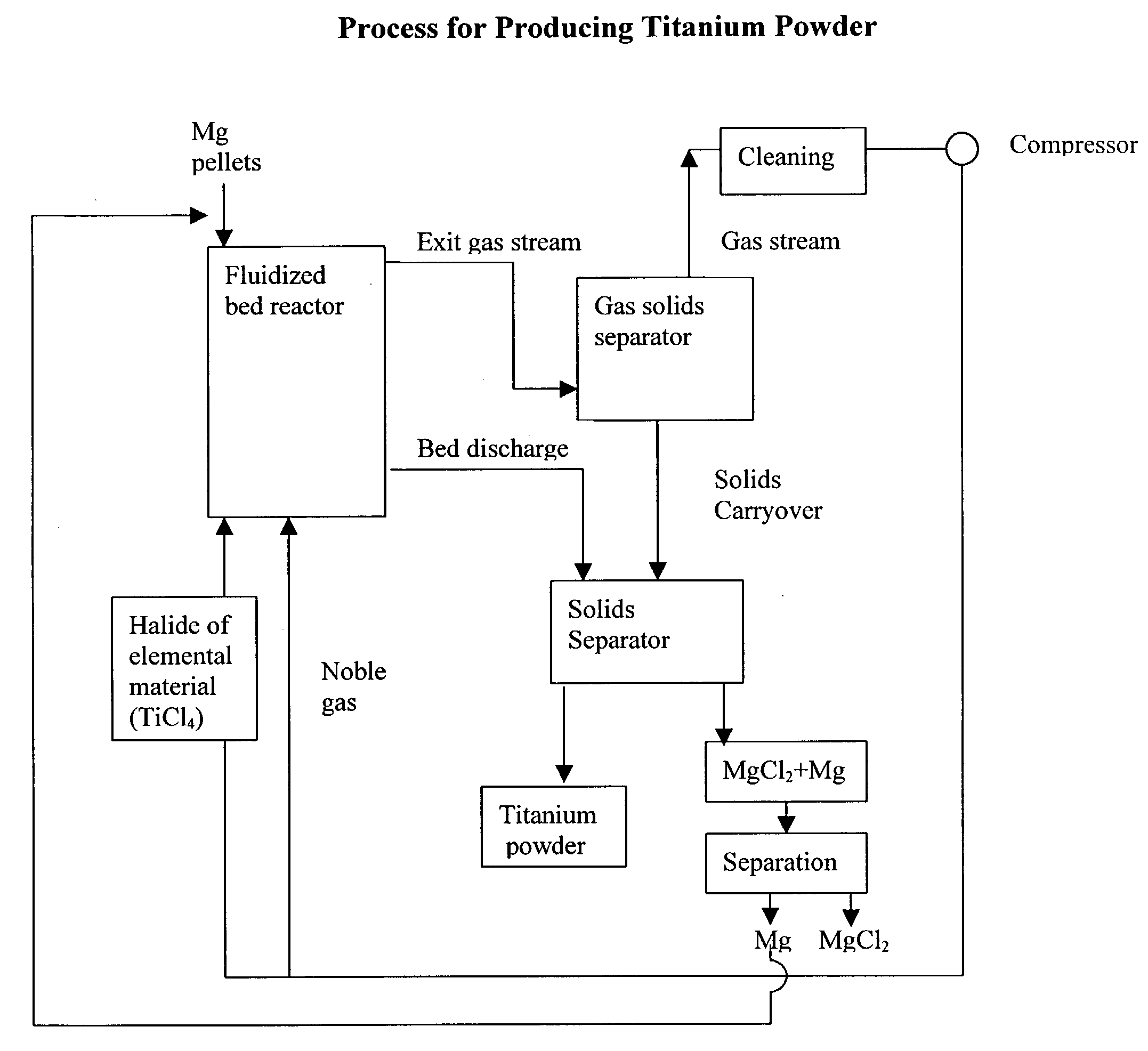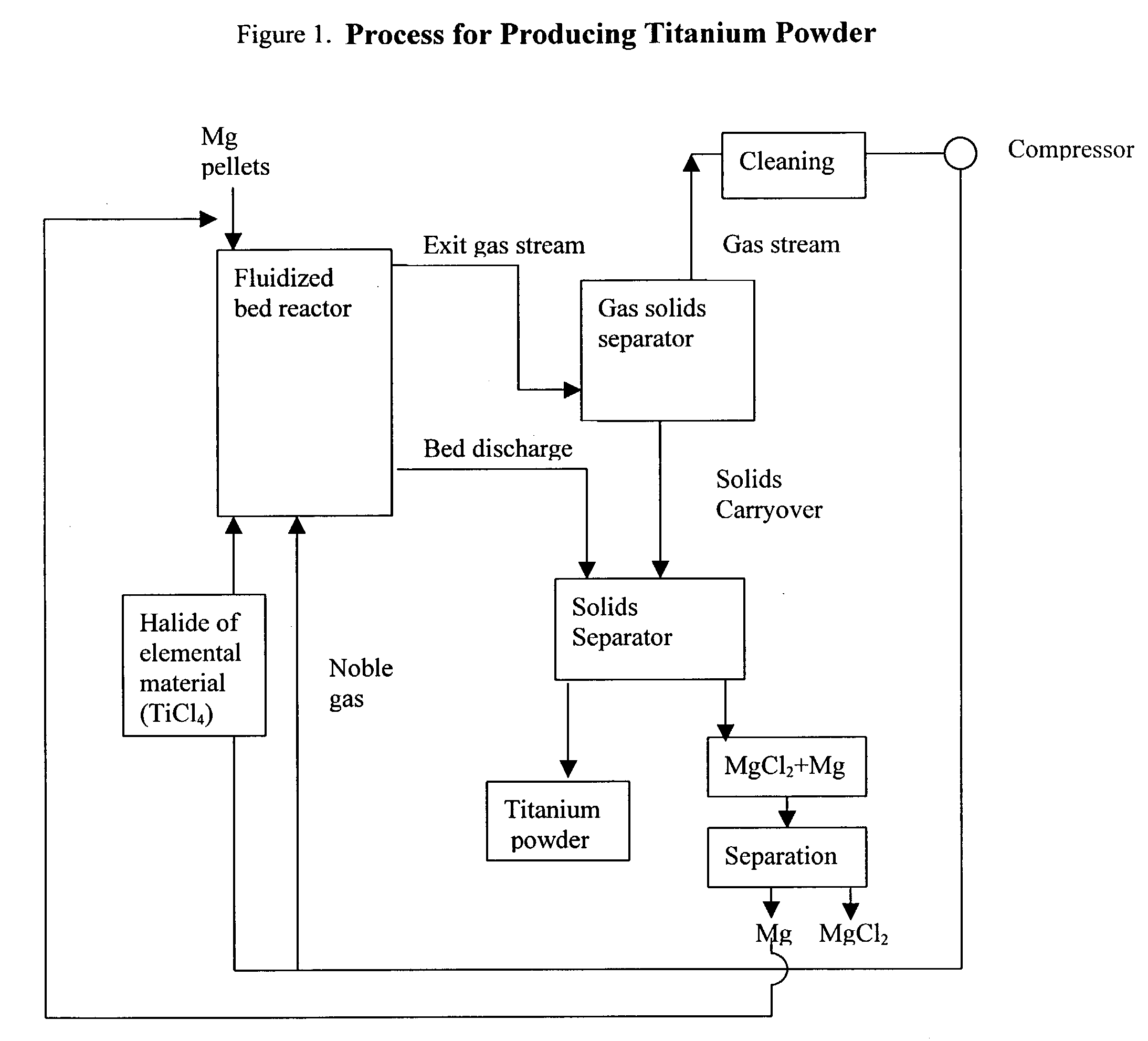Process for the production of elemental material and alloys
a technology of elemental materials and alloys, applied in the field of process for the production of elemental materials, can solve the problems of uncontrollable and sporadic reaction, increased product cost by a factor of two to three, laborious, etc., and achieves the effects of reducing material or agent, reducing energy consumption, and less expensiv
- Summary
- Abstract
- Description
- Claims
- Application Information
AI Technical Summary
Benefits of technology
Problems solved by technology
Method used
Image
Examples
example 1
[0043] 150 grams of magnesium granules (-20+100 mesh, Stock#00869, obtained from Alfa Aesar) were placed in a custom-made quartz fluidized bed reactor (55 mm ID, length=about 3 feet). A quartz fritted disc (55 mm diameter, made by Heraeus-Amersil) was used as the bed support. Argon was introduced at the bottom of the reactor as the fluidizing gas. The reactor was heated to 450.degree. C. in a furnace while the bed was fluidizing. The superficial gas velocity of argon was 0.8 ft / sec and the flowrate was 14.4 liters / min. When the bed temperature reached 450.degree. C., TiCl.sub.4 vapor was introduced into the fluidized bed reactor to begin the reduction reaction. The TiCl.sub.4 vapor was introduced into the fluidized bed reactor by passing some of the argon through a heated container holding TiCl.sub.4 vapor and then feeding the exhaust stream from that container (i.e., argon and TiCl.sub.4 vapor) into the bottom of the reactor. The bed temperature was gradually increased to 620.degre...
example 2
[0052] 448 grams of a previously used bed which initially consisted of silicon (+140 mesh, a sample from Union Carbide), and, at the time of this experiment comprised 24% magnesium silicides and 76% of silicon, were placed in a custom-made quartz fluidized bed reactor (55 mm ID, length=about 3 feet). A quartz fritted disc (55 mm diameter, Heraeus-Amersil) was used as the bed support. The reactor was coated with TiN inside (by spray painting with a TiN paint) to prevent reaction between reductant metal and the quartz reactor. Argon was introduced at the bottom of the reactor as the fluidizing gas. The reactor was heated to 550.degree. C. in a furnace while the bed was fluidizing. The superficial gas velocity of argon was 0.34 ft / s and the flowrate was 5.2 liters / min. When the bed temperature reached 550.degree. C., TiCl.sub.4 vapor was introduced into the fluidized bed reactor to begin the reduction reaction. After TiCl.sub.4 was introduced for 29 minutes, 124 grams of magnesium meta...
PUM
| Property | Measurement | Unit |
|---|---|---|
| size | aaaaa | aaaaa |
| temperatures | aaaaa | aaaaa |
| temperatures | aaaaa | aaaaa |
Abstract
Description
Claims
Application Information
 Login to View More
Login to View More - R&D
- Intellectual Property
- Life Sciences
- Materials
- Tech Scout
- Unparalleled Data Quality
- Higher Quality Content
- 60% Fewer Hallucinations
Browse by: Latest US Patents, China's latest patents, Technical Efficacy Thesaurus, Application Domain, Technology Topic, Popular Technical Reports.
© 2025 PatSnap. All rights reserved.Legal|Privacy policy|Modern Slavery Act Transparency Statement|Sitemap|About US| Contact US: help@patsnap.com



